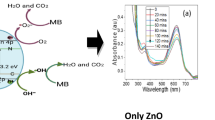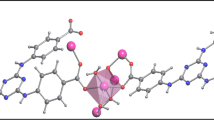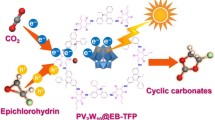Abstract
The one-pot synthesis of inorganic–organic hybrid materials via combination of sol–gel process and nucleophilic aromatic substitution reaction of various fluoro aromatic compounds and 3-aminopropyltrimethoxysilane has been studied. Both, nucleophilic aromatic substitution reaction and sol–gel process can be accomplished in the same reaction vessel due to the sol–gel precursor tetraethoxysilane acting as solvent during the first reaction step. Hydrogen fluoride, which forms as a by-product of the substitution reaction, is trapped by both silane species present and subsequently serves as catalyst during the sol–gel process. The obtained materials can be classified as type II xerogels, because of the covalent linkage between organic chromophor and inorganic silicon network. Fluoro aromatic compounds with different reactivities for nucleophilic aromatic substitution reactions containing azo, azomethine, and diphenylamine groups were used in order to (1) demonstrate the synthetic concept and (2) fine-tune the optical properties of the resulting chromophoric xerogels. The final chromophor content within the xerogels was varied by modifying the ratio of organosilicon precursor and tetraethoxysilane. All obtained organic–inorganic hybrid materials were characterized in detail using solid state NMR- and UV/vis spectroscopy. Latter one gave experimental confirmation of the partial hydrolysis of azomethine dyes in the xerogels, while no decomposition of azo or diphenylamine dyes was observed.









Similar content being viewed by others
Abbreviations
- APS:
-
3-Aminopropyltrimethoxysilane
- SNAr:
-
Nucleophilic aromatic substitution
- TEOS:
-
Tetraethoxysilane
- CP:
-
Cross polarization
- MAS:
-
Magic angle spinning
- TG:
-
Thermogravimetric analysis
- FNA:
-
4-Fluoro-3-nitroaniline
References
Brinker C, Scherer G (1990) Sol-gel science: the physics and chemistry of sol-gel processing. Academic Press, New York
Novak BM (1993) Hybrid nanocomposite materials—between inorganic glasses and organic polymers. Adv Mater 5:422–433
Gomez-Romero P, Sanchez C (2004) Functional hybrid materials. Wiley-VCH, Weinheim
Sanchez C, Lebeau B, Chaput F, Boilot J-P (2003) Optical properties of functional hybrid organic-inorganic nanocomposites. Adv Mater 15:1969–1994
Slowing II, Trewyn BG, Giri S, Lin VSY (2007) Mesoporous silica nanoparticles for drug delivery and biosensing applications. Adv Funct Mater 17:1225–1236
Kresge CT, Leonowicz ME, Roth WJ, Vartuli JC, Beck JS (1992) Ordered mesoporous molecular sieves synthesized by a liquid-crystal template mechanism. Nature 359:710–712
Beck JS, Vartuli JC, Roth WJ, Leonowicz ME, Kresge CT, Schmitt KD, Chu CTW, Olson DH, Sheppard EW (1992) A new family of mesoporous molecular sieves prepared with liquid crystal templates. J Am Chem Soc 114:10834–10843
Yanagisawa T, Shimizu T, Kuroda K, Kato C (1990) The preparation of alkyltrimethylammonium–kanemite complexes and their conversion to microporous materials. Bull Chem Soc Jpn 63:988–992
Inagaki S, Fukushima Y, Kuroda K (1993) Synthesis of highly ordered mesoporous materials from a layered polysilicate. J Chem Soc Chem Commun 680–682
Stein A, Melde BJ, Schroden RC (2000) Hybrid inorganic-organic mesoporous silicates—nanoscopic reactors coming of age. Adv Mater 12:1403–1419
Sanchez C, Ribot F (1994) Design of hybrid organic-inorganic materials synthesized via sol-gel chemistry. New J Chem 18:1007–1047
Clark JH, Macquarrie DJ (1998) Catalysis of liquid phase organic reactions using chemically modified mesoporous inorganic solids. Chem Commun 853–860
Roth I, Jbarah AA, Holze R, Friedrich M, Spange S (2006) 2-Nitro-1, 4-diaminobenzene-functionalized poly(vinyl amine)s as water-soluble UV-vis-sensitive pH sensors. Macromol Rapid Commun 27:193–199
Roth I, Spange S (2005) Kinetic studies on the nucleophilic aromatic substitution of fluoronitrobenzene derivatives with polyvinylamine in water mediated by 2, 6-O-dimethyl-beta-cyclodextrin. Macromolecules 38:10034–10041
Roth I, Spange S (2001) Nucleophilic substitution of 4-fluoronitrobenzene with polyvinylamine in water mediated by cyclodextrins. Macromol Rapid Commun 22:1288–1291
Roth I, Simon F, Bellmann C, Seifert A, Spange S (2006) Fabrication of silica particles functionalized with chromophores and amino groups using synergism of poly(vinylamine) adsorption and nucleophilic aromatic substitution with fluoroaromatics. Chem Mater 18:4730–4739
Seifert A, Roth I, Spange S, Moszner N (2003) Nucleophile aromatische Substitution als Werkzeug zur Funktionalisierung von Polyvinylamin und Hybridmaterialien. Macromol Chem Phys 204:F30–F31
Schreiter K, Spange S (2008) Amino-acid-functionalized solvatochromic probes. J Phys Org Chem 21:242–250
Spange S, Hofmann K, Walfort B, Rueffer T, Lang H (2005) Chiral 1, 2- and 1, 3-diol-functionalized chromophores as Lego building blocks for coupled structures. J Org Chem 70:8564–8567
Suhr H (1965) Nucleophilic substitutions. V. Reaction of 4-nitrofluorobenzene and primary amines. Ann 687:175–182
Alvaro CES, Nudelman NS (2005) Role of hydrogen-bonded nucleophiles in aromatic nucleophilic substitutions in aprotic solvents. Reactions of halonitrobenzenes with ethylenediamine, 3-dimethylamino-1-propylamine and histamine in toluene. J Phys Org Chem 18:880–885
Seifert A, Spange S, Mueller H, Hesse S, Jaeger C (2003) Fabrication of chromophoric xerogels by synergistic combination of nucleophilic aromatic substitution and the sol-gel process. J Sol-Gel Sci Technol 26:77–81
Spange S, Seifert A, Muller H, Hesse S, Jager C (2002) A one-pot synthesis of chromophoric silicate-based xerogels. Angew Chem Int Ed 41:1729–1732
Kamlet MJ, Abboud JL, Taft RW (1977) The solvatochromic comparison method. 6. The pi* scale of solvent polarities. J Am Chem Soc 99:6027–6038
Kamlet MJ, Abboud JLM, Abraham MH, Taft RW (1983) Linear solvation energy relationships. 23. A comprehensive collection of the solvatochromic parameters, pi*, alpha, and beta, and some methods for simplifying the generalized solvatochromic equation. J Org Chem 48:2877–2887
Kamlet MJ, Taft RW (1976) The solvatochromic comparison method. I. The beta -scale of solvent hydrogen-bond acceptor (HBA) basicities. J Am Chem Soc 98:377–383
Laurence C, Nicolet P, Dalati MT, Abboud J-LM, Notario R (1994) The empirical treatment of solvent-solute interactions: 15 years of pi*. J Phys Chem 98:5807–5816
Helburn R, Dijiba Y, Mansour G, Maxka J (1998) New hydrophobic pi* indicators. Solvatochromic properties and interactions in micellar solutions. Langmuir 14:7147–7154
Helburn R, Ullah N, Mansour G, Maxka J (1997) Towards a homologous structural series of solvatochromic pi indicators. J Phys Org Chem 10:42–48
Moszner N, Klapdohr S (2004) Nanotechnology for dental composites. Int J Nanotechnol 1:130–156
Matsui K, Soeda Y, Otaguro K, Kuroda T (1965) Halobenzene reactive dyes. VII. Synthesis and reactivity of primary condensation products of 1, 3-difluoro-4, 6-dinitrobenzene. Kogyo Kagaku Zasshi 68:507–512
Hantzsch A (1910) Chromisomerism and Homochromisomerism of Nitroanilines. Ber 43:1662–1685
Yagupolskij LM, Gandelsman LZ (1965) The effect of substituents on the color of N,N-dialkylamino azo dyes and their salts. Zh Obshch Khim 35:1252
Mustroph H (1987) Studies on UV/visible absorption spectra of azo dyes. XVII. A modified increment system for the calculation of the absorption maxima of polysubstituted azobenzenes. J Prakt Chem 329:157–161
Mustroph H, Marx J, Epperlein J (1983) Studies of the photochemical fading of tautomeric azo dyes. II. Fading studies of 1-(phenylazo)-2-naphthols in cellulose acetate. Acta Polym 34:336–339
Neunhoeffer O, Ruske W (1957) Nitro-substituted N-(4-phenylazophenyl)amino acids. Ann 610:143–156
Borsche W (1923) Beta -Nitroarylhydroxylamines. I. beta -2, 4- and beta -2, 6-dinitrophenylhydroxylamine. Chem Ber 56B:1494–1501
Huggett AC, Cone JL, Thorgeirsson SS, Roller PP (1987) Novel synthesis and spectral characterization of an N-acetoxyarylamine: N-acetoxy-2, 4-dinitrophenylamine. J Org Chem 52:4933–4937
Hofmann K, Schreiter K, Seifert A, Ruffer T, Lang H, Spange S (2008) Solvatochromism and linear solvation energy relationship of diol- and proline-functionalized azo dyes using the Kamlet-Taft and Catalan solvent parameter sets. New J Chem 32:2180–2188
Abramenko VL, Sergienko VS (2002) Molecular complexes and chelates of dioxomolybdenum(VI) with salicylidene-RF-phenylimines (HL). The crystal and molecular structures of dioxo(salicylidene-3-(4-)-F-phenyliminato)molybdenum(VI), MoO2L2. Zh Neorg Khim 47:915–923
Morcombe CR, Zilm KW (2003) Chemical shift referencing in MAS solid state NMR. J Magn Reson 162:479–486
Joseph R, Zhang S, Ford WT (1996) Structure and dynamics of a colloidal silica-poly(methyl methacrylate) composite by 13C and 29Si MAS NMR spectroscopy. Macromolecules 29:1305–1312
Milligan RF (1950) Higher members of the Wurster salts series. J Am Chem Soc 72:2775–2776
Enkelmann V (1991) New building blocks for organic metals. Angew Chem 103:1142–1144
Hansch C, Leo A, Taft RW (1991) A survey of Hammett substituent constants and resonance and field parameters. Chem Rev 91:165–195
Acknowledgments
Financial support by the Deutsche Forschungsgemeinschaft and the Fonds der Chemischen Industrie is gratefully acknowledged.
Author information
Authors and Affiliations
Corresponding author
Electronic supplementary material
Below is the link to the electronic supplementary material.
Rights and permissions
About this article
Cite this article
Seifert, A., Ladewig, K., Schönherr, P. et al. Synthesis of dye functionalized xerogels via nucleophilic aromatic substitution of fluoro aromatic compounds with aminosilanes. J Sol-Gel Sci Technol 53, 328–341 (2010). https://doi.org/10.1007/s10971-009-2096-x
Received:
Accepted:
Published:
Issue Date:
DOI: https://doi.org/10.1007/s10971-009-2096-x




